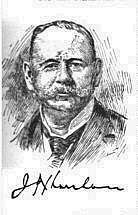James Theodore Harahan

James Theodore Harahan (1841–1912) was born on January 12, 1841 in Lowell, Massachusetts, the son of Thomas Harahan and Ann née McCuen of Scotch-Irish ancestry, both immigrants from Ireland.[1] He worked for railroad companies as a young man, including as a brakeman, eventually becoming president of the Illinois Central Railroad from November 7, 1906 to 1911 succeeding Stuyvesant Fish.[2][3]
Harahan served as a captain in the Union Army during the American Civil War. Captain Harahan married to Mary Kehoe of New Orleans, Louisiana in 1866.[4][5] Four children were born of this marriage including his son, William Johnson Harahan. William was born in Nashville, Tennessee on December 22, 1867, and was twice president of the Chesapeake & Ohio Railroad. He died of natural causes in 1937 in Clifton Forge, Virginia.
James Harahan's second marriage was to Mary N. Mallory of Montgomery County, Tennessee on April 14, 1899.[2][5]
Death and aftermath
James Harahan was killed in a train accident in his own private car in 1912 in Kinmundy, Illinois while en route to Memphis, Tennessee with three other executives. They were traveling to a meeting to discuss the building of a bridge across the Mississippi River. The bridge was named Harahan Bridge when it opened in 1914. The locomotive pulling Harahan's car was previously driven by legendary railroad engineer Casey Jones during the fatal collision of April 30, 1900 in which Jones was killed. The city of Harahan, Louisiana is also named after him.[5][6]
Notes
- ↑ Frederick Converse Beach, editor, The Americana, New York (1911), page 49
- 1 2 The Americana, ibid.
- ↑ New York Times article, November, 1906
- ↑ William Henry Perrin, editor, "History of Bourbon, Scott, Harrison and Nicholas Counties, Kentucky", Chicago, 1882. p. 751. (Nicholas County, Carlisle City and Precinct, Thomas Kehoe biographical sketch)
- 1 2 3 Ned Hémard, New Orleans Nostalgia, Harahan History, New Orleans Bar Association, 2009
- ↑ New York Times article, January 23, 1912